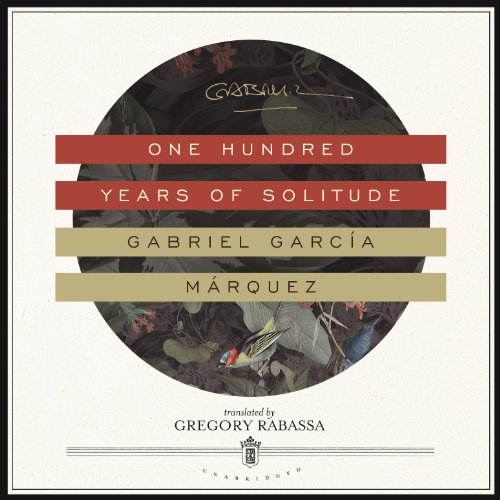
[Translated by Gregory Rabassa]
[Read by John Lee]
One of the twentieth century’s enduring works, One Hundred Years of Solitude is a widely beloved and acclaimed novel known throughout the world and the ultimate achievement in a Nobel Prize-winning career.
The novel tells the story of the rise and fall of the mythical town of Macondo through the history of the Buendía family. Rich and brilliant, it is a chronicle of life, death, and the tragicomedy of humankind. In the beautiful, ridiculous, and tawdry story of the Buendía family, one sees all of humanity, just as in the history, myths, growth, and decay of Macondo, one sees all of Latin America.
Love and lust, war and revolution, riches and poverty, youth and senility, the variety of life, the endlessness of death, the search for peace and truth — these universal themes dominate the novel. Alternately reverential and comical, One Hundred Years of Solitude weaves the political, personal, and spiritual to bring a new consciousness to storytelling. Translated into dozens of languages, this stunning work is no less than an account of the history of the human race.”Many years later, as he faced the firing squad, Colonel Aureliano Buendía was to remember that distant afternoon when his father took him to discover ice.”
It is typical of Gabriel García Márquez that it will be many pages before his narrative circles back to the ice, and many chapters before the hero of One Hundred Years of Solitude, Buendía, stands before the firing squad. In between, he recounts such wonders as an entire town struck with insomnia, a woman who ascends to heaven while hanging laundry, and a suicide that defies the laws of physics: A trickle of blood came out under the door, crossed the living room, went out into the street, continued on in a straight line across the uneven terraces, went down steps and climbed over curbs, passed along the Street of the Turks, turned a corner to the right and another to the left, made a right angle at the Buendía house, went in under the closed door, crossed through the parlor, hugging the walls so as not to stain the rugs, went on to the other living room, made a wide curve to avoid the dining-room table, went along the porch with the begonias, and passed without being seen under Amaranta’s chair as she gave an arithmetic lesson to Aureliano José, and went through the pantry and came out in the kitchen, where Úrsula was getting ready to crack thirty-six eggs to make bread.
“Holy Mother of God!” Úrsula shouted.
The story follows 100 years in the life of Macondo, a village founded by José Arcadio Buendía and occupied by descendants all sporting variations on their progenitor’s name: his sons, José Arcadio and Aureliano, and grandsons, Aureliano José, Aureliano Segundo, and José Arcadio Segundo. Then there are the women–the two Úrsulas, a handful of Remedios, Fernanda, and Pilar–who struggle to remain grounded even as their menfolk build castles in the air. If it is possible for a novel to be highly comic and deeply tragic at the same time, then One Hundred Years of Solitude does the trick. Civil war rages throughout, hearts break, dreams shatter, and lives are lost, yet the effect is literary pentimento, with sorrow’s outlines bleeding through the vibrant colors of García Márquez’s magical realism. Consider, for example, the ghost of Prudencio Aguilar, whom José Arcadio Buendía has killed in a fight. So lonely is the man’s shade that it haunts Buendía’s house, searching anxiously for water with which to clean its wound. Buendía’s wife, Úrsula, is so moved that “the next time she saw the dead man uncovering the pots on the stove she understood what he was looking for, and from then on she placed water jugs all about the house.”
With One Hundred Years of Solitude Gabriel García Márquez introduced Latin American literature to a world-wide readership. Translated into more than two dozen languages, his brilliant novel of love and loss in Macondo stands at the apex of 20th-century literature. –Alix Wilber

A masterpiece. Classic The beginning of the book contains a family tree of the Buendia family, and if you’re like me you’ll surely mangle and dog-ear this page as you work your way though the book, trying to keep track of the Aurelianos, Remedios, and Ursulas.But the struggle is worth it. This was truly the great novel that Garcia Marquez was meant to write; to me everything of Marquez that followed seems like recycled material. I first read One Hundred Years of Solitude years ago before moving to Latin…
Tragi-Comic Masterpiece of Epic Proportions One Hundred Years of Solitude, the greatest of all Latin American novels is the magic and multi-layered epic of the Buendia family and the story of their jungle settlement, Macondo.Like many other epics, this book has deeply-rooted connections with historical reality, i.e., the development of Colombia since its independence from Spain in the early 19th century. The story of the Buendia family is obviously a metaphor for Colombia in the neocolonial period as well as a narrative…
Mesmerizing and Marvelous There are relatively few books that I’ve had to read for my college classes and truly enjoyed. This was one of them.Now, be warned: this is not a clear-cut story; the prose can be confusing, and the repetition of names makes it more difficult by far to keep track of who is who. The novel does indeed cover one hundred years, so expect to see favorite characters die if they first appear early on. There is no one protagonist. The family is the protagonist–the family, and the…